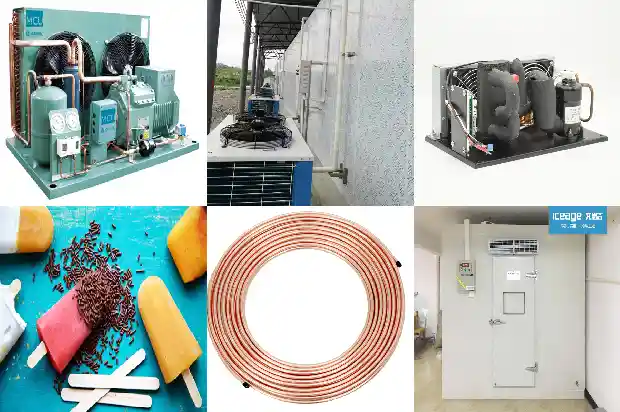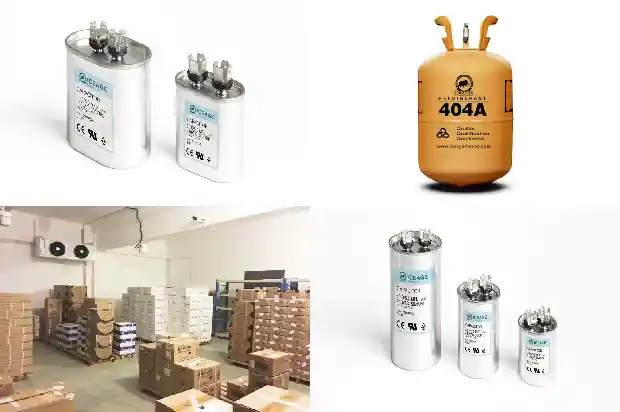What is the Air - conditioner Jet Enthalpy - increasing Technology?
2025-01-04
How can an air conditioner ensure normal and efficient operation at ultra - low temperatures? At this time, the first thing that comes to mind is the air conditioner's jet - enthalpy - increasing technology. That's right, it is the jet - enthalpy - increasing technology.
The Purpose of Jet - Enthalpy - Increasing Technology
To understand the jet - enthalpy - increasing technology, we must clarify its purpose: to solve the problem of low - temperature heating.
In winter, an air conditioner extracts heat from the outdoor air and sends it into the room. This is the principle of air - conditioner heating. The jet - enthalpy - increasing technology is to strengthen this heat - extraction process, enabling more outdoor heat to be transferred indoors.
To understand the jet - enthalpy - increasing technology, we must clarify its purpose: to solve the problem of low - temperature heating.

In winter, an air conditioner extracts heat from the outdoor air and sends it into the room. This is the principle of air - conditioner heating. The jet - enthalpy - increasing technology is to strengthen this heat - extraction process, enabling more outdoor heat to be transferred indoors.
The Principle of Jet - Enthalpy - Increasing Technology
The design concept of the jet - enthalpy - increasing technology is somewhat similar to the "turbocharging" of a car. Based on a jet - enthalpy - increasing compressor, it optimizes the medium - pressure refrigerant injection technology. It sucks in a part of the gas at the intermediate pressure through the intermediate - pressure suction port, mixes it with the partially compressed refrigerant, and then compresses it again. This enables two - stage compression with a single compressor, increases the refrigerant flow in the condenser, and enlarges the enthalpy difference in the main circulation loop, thus improving the efficiency of the compressor.
As we all know, the power of a car can be increased after turbocharging. In the "jet - enthalpy - increasing" system's internal circulation, the compressor goes through the indoor unit, capillary tube, outdoor unit, and then back in a cycle. In addition to this internal circulation, the jet - enthalpy - increasing system has an additional cycle, similar to exhaust - gas turbocharging. After coming out of the compressor, it goes to the indoor unit through the four - way valve, then through the capillary tube and evaporator to the outdoor unit in a cycle, which is the same as the normal one.
In addition, the jet - enthalpy - increasing system is a low - temperature and high - heat scroll compressor, and it adds several key components such as an evaporator, a heating low - temperature one - way solenoid valve, a heating one - way solenoid valve, and a high - heat - output evaporator. Part of the refrigerant directly undergoes enthalpy - increasing through the compressor, which is equivalent to supercharging, so as to increase the heating capacity.
The design concept of the jet - enthalpy - increasing technology is somewhat similar to the "turbocharging" of a car. Based on a jet - enthalpy - increasing compressor, it optimizes the medium - pressure refrigerant injection technology. It sucks in a part of the gas at the intermediate pressure through the intermediate - pressure suction port, mixes it with the partially compressed refrigerant, and then compresses it again. This enables two - stage compression with a single compressor, increases the refrigerant flow in the condenser, and enlarges the enthalpy difference in the main circulation loop, thus improving the efficiency of the compressor.
As we all know, the power of a car can be increased after turbocharging. In the "jet - enthalpy - increasing" system's internal circulation, the compressor goes through the indoor unit, capillary tube, outdoor unit, and then back in a cycle. In addition to this internal circulation, the jet - enthalpy - increasing system has an additional cycle, similar to exhaust - gas turbocharging. After coming out of the compressor, it goes to the indoor unit through the four - way valve, then through the capillary tube and evaporator to the outdoor unit in a cycle, which is the same as the normal one.
In addition, the jet - enthalpy - increasing system is a low - temperature and high - heat scroll compressor, and it adds several key components such as an evaporator, a heating low - temperature one - way solenoid valve, a heating one - way solenoid valve, and a high - heat - output evaporator. Part of the refrigerant directly undergoes enthalpy - increasing through the compressor, which is equivalent to supercharging, so as to increase the heating capacity.
The "Three Major Components" of Jet - Enthalpy - Increasing
It is actually composed of three major components: a jet - enthalpy - increasing compressor, jet - enthalpy - increasing technology, and a high - efficiency sub - cooler. The new system composed of these three major components is an organic whole, which can provide high - efficiency performance, ensuring that the air conditioner can operate normally and efficiently at low temperatures, and enabling the air conditioner to heat quickly and stably in low - temperature environments.
It is actually composed of three major components: a jet - enthalpy - increasing compressor, jet - enthalpy - increasing technology, and a high - efficiency sub - cooler. The new system composed of these three major components is an organic whole, which can provide high - efficiency performance, ensuring that the air conditioner can operate normally and efficiently at low temperatures, and enabling the air conditioner to heat quickly and stably in low - temperature environments.
- Jet - Enthalpy - Increasing Compressor
The jet - enthalpy - increasing compressor adopts a two - stage throttling and intermediate jet technology, and uses a flash tank for gas - liquid separation to achieve the enthalpy - increasing effect. It mixes and cools while compressing at medium and low pressures, and then compresses normally at high pressures, increasing the compressor's displacement and achieving the goal of enhancing the heating capacity in a low - temperature environment. - High - Efficiency Sub - cooler
The high - efficiency sub - cooler also plays a crucial role in the entire system. On the one hand, it sub - cools the refrigerant in the main circulation loop before throttling, increasing the enthalpy difference. On the other hand, it appropriately pre - heats the low - pressure and low - temperature refrigerant that has passed through the electronic expansion valve and been depressurized in the auxiliary loop (this refrigerant will be introduced into the compressor from the middle and directly participate in the compression), so as to reach an appropriate medium pressure and supply it to the compressor for secondary compression. - Jet - Enthalpy - Increasing Technology
The compressor of the jet - enthalpy - increasing technology has an additional suction port. It cools the refrigerant in the main circulation by generating steam, which enters the compressor from the second suction port. Its compression process is divided into two sections by the gas - supplementing process, becoming a quasi - two - stage compression process. Jetting reduces the exhaust temperature and its exhaust superheat, shortens the length of the gas - phase heat - transfer area in the condenser, increases the two - phase heat - transfer area, and improves the heat - transfer efficiency of the condenser. The greater the difference between the evaporation temperature and the condensation temperature, the better the effect, so it is more obvious in a low - temperature environment.
The Advantages of Jet - Enthalpy - Increasing Technology
Some researchers have conducted experiments on jet - enthalpy - increasing. The experimental comparison shows that:
Some researchers have conducted experiments on jet - enthalpy - increasing. The experimental comparison shows that:
- In standard - condition refrigeration, the energy efficiency is comparable. The heating capacity and energy - efficiency ratio of a common air conditioner and a certain jet - enthalpy - increasing air conditioner are also comparable.
- In the heating state, the energy - efficiency standard condition and heating capacity of the jet - enthalpy - increasing air conditioner are increased by more than 10%, and the energy - efficiency ratio is much higher than that of a common air conditioner (3.06 and 3.38).
- For full - condition heating, with the outdoor condition ranging from - 15 °C to 15 °C and the indoor condition adjusted to 20 °C, under various conditions, the heating capacity of a certain jet - enthalpy - increasing air conditioner is 25% higher than that of a conventional one. Moreover, the lower the outdoor temperature, the more significant its heating capacity.
- Under the same air volume, the air - outlet temperature of a certain jet - enthalpy - increasing air conditioner is higher than normal temperature. It can be 5 - 7 °C higher at low temperatures, providing a very comfortable hot - air feeling.
- In the same room, when reaching the same temperature, a certain jet - enthalpy - increasing air conditioner takes 1/10 less time than a conventional one.
This set of experimental data may vary depending on different air conditioners. However, it is undeniable that the enthalpy - increasing technology does not affect the refrigeration capacity and energy efficiency, and it can effectively improve the heating capacity and energy efficiency, especially saving electricity at low temperatures.
In reality, it has also been proven that jet - enthalpy - increasing products can achieve heating operation within - 25 °C - 29 °C. By increasing the enthalpy through jetting, the heating capacity of the compressor in severe cold is increased. The heating capacity is increased by nearly 20% - 50% at - 15 °C, which gives multi - connected units an even greater advantage in "strong heating and cooling".
Jet - Enthalpy - Increasing Technology for Air - Source Heat Pumps
Low - ambient - temperature air - source heat pumps use part of the electrical energy, adopt a refrigeration compression cycle, and transfer the heat in the outdoor air to the indoor through the refrigerant to increase the indoor temperature. Air - source heat pumps only extract heat from the environment. Currently, South Korea, Europe, etc. have widely adopted low - ambient - temperature air - source heat pumps for winter heating. The promotion of low - ambient - temperature air - source heat pumps in China is relatively slow.
The refrigerant coming out of the condenser is divided into two paths: the main loop is the refrigeration loop, and the branch is the jet loop. The refrigerant liquid in the main loop directly enters the plate heat exchanger, and the refrigerant in the branch is throttled and depressurized by the expansion valve before entering the plate heat exchanger. These two parts of the refrigerant exchange heat in the plate heat exchanger. The refrigerant in the main loop releases heat and becomes a sub - cooled liquid, and after being depressurized by the expansion valve, it enters the evaporator. The refrigerant in the branch absorbs heat and turns into gas, which is sprayed into the scroll compression chamber from the compressor's injection port.
The application advantages of the jet - enthalpy - increasing air - source heat - pump system compared with a common air - source heat pump are as follows:
First, in the refrigeration cycle, by using the method of single - stage throttling and intermediate cooling and exchanging heat through a plate heat exchanger, the refrigerant liquid in the main loop is fully sub - cooled to obtain an additional sub - cooling degree, enabling the refrigerant to obtain more heat from the indoor air.
Second, in the heating cycle, the mass flow in the condenser is the sum of the main flow and the injection flow, improving the heating capacity.
Third, when heating at low - ambient - temperatures, the intermediate gas - supplementing of jet - enthalpy - increasing significantly improves the compression process, reduces the exhaust temperature, and expands the application range of the air - source heat pump.
In the cold regions of northern China, when promoting heat - pump water heaters to produce domestic hot water, the compressor of the heat - pump water heater is required to operate under high - compression - ratio and high - pressure - difference conditions. A common heat - pump compressor cannot meet this requirement due to high exhaust temperature. The compressor for heat - pump water heaters developed using jet - enthalpy - increasing technology controls the exhaust temperature through wet - steam injection compression, ensuring the reliable operation of the compressor. Figure 4 shows the operating conditions of the compressor of a heat - pump water heater using a certain model of Copeland ZWKS jet - enthalpy - increasing scroll compressor when producing 60 °C domestic hot water at different ambient temperatures. It can be seen that when producing 60 °C domestic hot water at an ambient temperature of - 15 °C, the compressor of the heat - pump water heater still operates within a reliable range.
Low - ambient - temperature air - source heat pumps use part of the electrical energy, adopt a refrigeration compression cycle, and transfer the heat in the outdoor air to the indoor through the refrigerant to increase the indoor temperature. Air - source heat pumps only extract heat from the environment. Currently, South Korea, Europe, etc. have widely adopted low - ambient - temperature air - source heat pumps for winter heating. The promotion of low - ambient - temperature air - source heat pumps in China is relatively slow.

The refrigerant coming out of the condenser is divided into two paths: the main loop is the refrigeration loop, and the branch is the jet loop. The refrigerant liquid in the main loop directly enters the plate heat exchanger, and the refrigerant in the branch is throttled and depressurized by the expansion valve before entering the plate heat exchanger. These two parts of the refrigerant exchange heat in the plate heat exchanger. The refrigerant in the main loop releases heat and becomes a sub - cooled liquid, and after being depressurized by the expansion valve, it enters the evaporator. The refrigerant in the branch absorbs heat and turns into gas, which is sprayed into the scroll compression chamber from the compressor's injection port.

The application advantages of the jet - enthalpy - increasing air - source heat - pump system compared with a common air - source heat pump are as follows:
First, in the refrigeration cycle, by using the method of single - stage throttling and intermediate cooling and exchanging heat through a plate heat exchanger, the refrigerant liquid in the main loop is fully sub - cooled to obtain an additional sub - cooling degree, enabling the refrigerant to obtain more heat from the indoor air.
Second, in the heating cycle, the mass flow in the condenser is the sum of the main flow and the injection flow, improving the heating capacity.
Third, when heating at low - ambient - temperatures, the intermediate gas - supplementing of jet - enthalpy - increasing significantly improves the compression process, reduces the exhaust temperature, and expands the application range of the air - source heat pump.
In the cold regions of northern China, when promoting heat - pump water heaters to produce domestic hot water, the compressor of the heat - pump water heater is required to operate under high - compression - ratio and high - pressure - difference conditions. A common heat - pump compressor cannot meet this requirement due to high exhaust temperature. The compressor for heat - pump water heaters developed using jet - enthalpy - increasing technology controls the exhaust temperature through wet - steam injection compression, ensuring the reliable operation of the compressor. Figure 4 shows the operating conditions of the compressor of a heat - pump water heater using a certain model of Copeland ZWKS jet - enthalpy - increasing scroll compressor when producing 60 °C domestic hot water at different ambient temperatures. It can be seen that when producing 60 °C domestic hot water at an ambient temperature of - 15 °C, the compressor of the heat - pump water heater still operates within a reliable range.
Related Articles
- Influence of Fin Spacing of Evaporator in Air Cooler on Frost Formation
- Air - side Economizer
- Winter Approaches: How to Solve the Low High - pressure Issue of Air - cooled Condensing Units?
- What Are the Common Causes of Cold Air Blower Noise?
- How to Troubleshoot and Repair High - pressure Protection of Air - cooled Units?
- What Exactly Are the Ten Typical Malfunctions of Air Conditioners?
- What Misconceptions Should Be Avoided in Low - temperature Refrigeration System Repairs
- Practical Knowledge on Freeze Protection of Air - conditioning Equipment
- Remember! 3 Steps to Calculate Central Air - conditioner Cooling Capacity
- How to Read the High - and Low - Pressure Gauges of Refrigeration Air - conditioners?
- Analysis of Seven Reasons for Ice Formation in Computer Room Air Conditioners
- Air - conditioner Low - pressure Alarm? These Nine Common Causes
- Selection of Bypass Control Valves for Air - conditioning Water Systems
- Common Faults and Solutions of Central Air - conditioning Chiller Units
- Could a Tiny Copper Tube Cause a Multi - split Air Conditioner to Stop Cooling? Refrigeration Workers Must Pay Attention!
- Maintenance Techniques for Air - conditioning Refrigeration Systems
- Considerations in Selecting Packaged Air Conditioners and Their Heat Recovery Operations
- Characteristics and Differences among Water System, Air System and Refrigerant System
